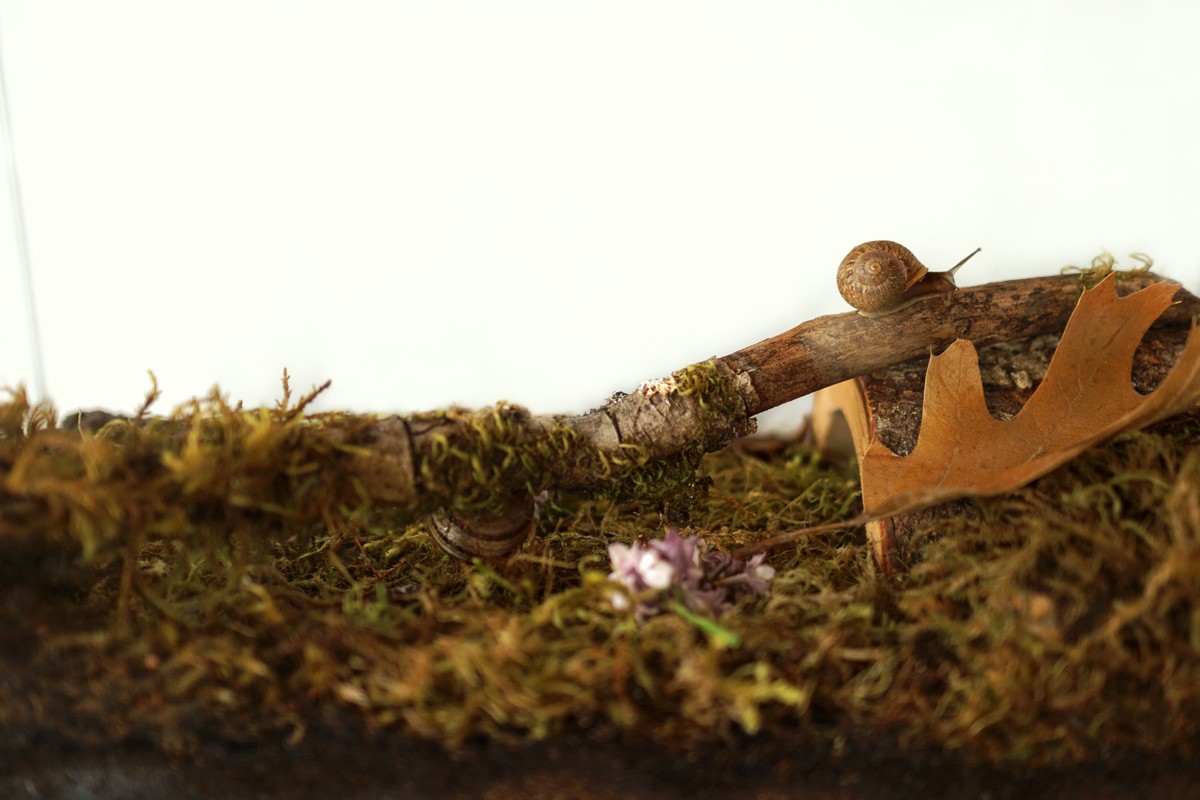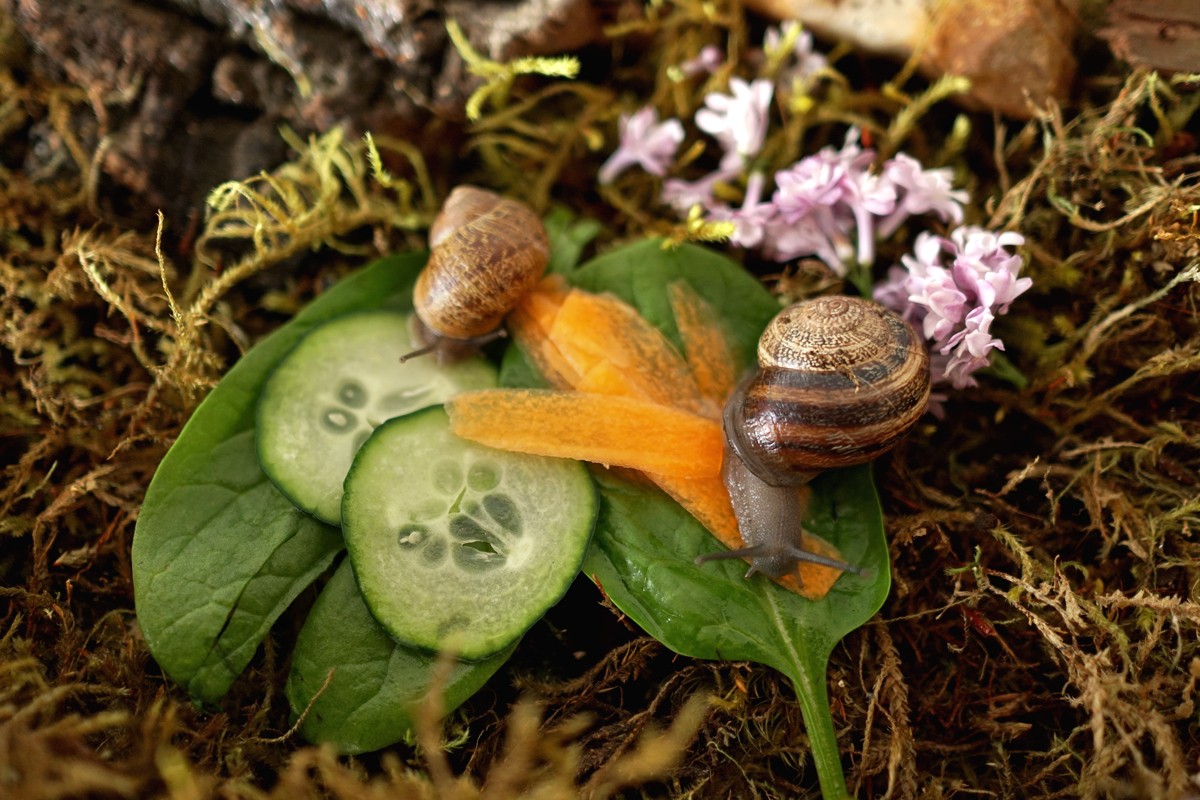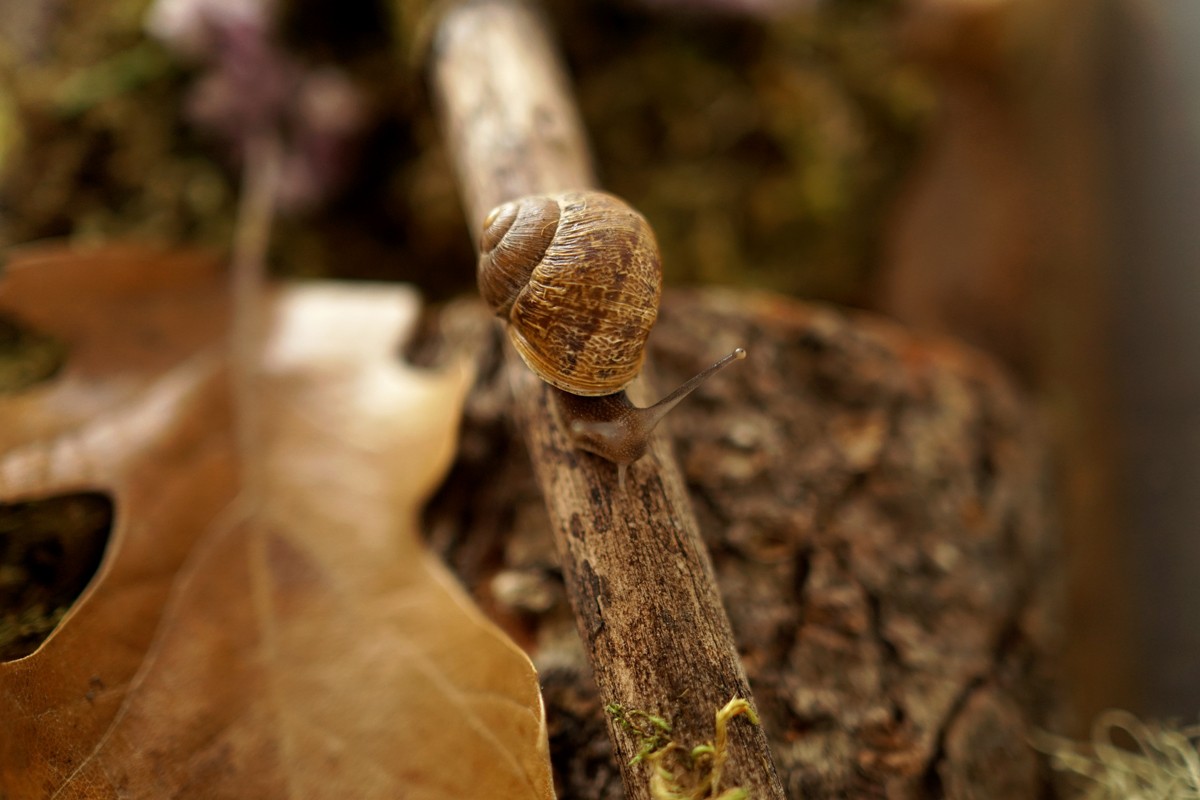Pet Snails, fascinating mollusks, are gaining popularity as low-maintenance and intriguing companions, and PETS.EDU.VN is here to help you navigate the wonderful world of snail keeping. From creating the perfect habitat to understanding their dietary needs, this comprehensive guide will equip you with everything you need to know about snail care, promoting happy and healthy snail keeping, with important tips regarding snail health and terrarium maintenance.
1. Unveiling the Allure of Pet Snails
Pet snails offer a unique blend of ease of care and captivating observation, making them ideal pets for people of all ages. These gentle creatures, belonging to the mollusk family rather than insects, are related to clams, oysters, and mussels. With an average lifespan of 5 years, and potentially up to 20 years in captivity, they offer a long-term commitment for dedicated pet keepers. Snail keeping provides educational opportunities, a calming hobby, and the chance to appreciate the often-overlooked beauty of nature.
1.1. Why Choose Snails As Pets?
- Low Maintenance: Snails require minimal attention compared to other pets, making them perfect for busy individuals.
- Educational: Observing their behavior provides insights into the natural world.
- Quiet Companions: Snails are silent pets, ideal for apartment living or noise-sensitive environments.
- Unique Charm: Their slow pace and intricate shells offer a calming and captivating presence.
- Cost-Effective: Setting up and maintaining a snail habitat is relatively inexpensive.
1.2. Legal Considerations and Ethical Sourcing
Before acquiring a pet snail, research local regulations regarding ownership of specific species, as some areas may restrict certain types to prevent ecological imbalances. Avoid collecting snails from the wild, as this can disrupt local ecosystems and potentially introduce diseases to your home. Instead, source snails from reputable breeders or pet stores that prioritize ethical breeding practices. This ensures you receive healthy snails and contribute to responsible pet ownership.
2. Selecting Your Snail Species
Choosing the right snail species is crucial for a fulfilling pet-keeping experience. Different species have varying needs and temperaments, so research is key. Consider factors such as size, lifespan, humidity requirements, and dietary preferences before making your decision. Common pet snail species include the Garden Snail (Cornu aspersum), the Giant African Land Snail (Achatina fulica), and the Milk Snail (Otala lactea).
2.1. Popular Pet Snail Species
| Snail Species | Size | Lifespan | Habitat | Diet | Notes |
|---|---|---|---|---|---|
| Garden Snail (Cornu aspersum) | Small | 1-2 years | Temperate, humid environments with plenty of hiding places | Decaying plant matter, fruits, vegetables, calcium sources | Common and easy to care for, but can be considered pests in some areas. |
| Giant African Land Snail (Achatina fulica) | Large | 5-7 years | Tropical, high-humidity environments with ample space for burrowing | Leafy greens, fruits, vegetables, calcium sources, protein supplements | Requires strict regulation due to invasive potential. Can grow quite large, needing a substantial enclosure. |
| Milk Snail (Otala lactea) | Medium | 2-3 years | Mediterranean-like, moderately humid environments with dry periods | Various fruits, vegetables, and grains. Prefers drier conditions than other common pet snails. | More tolerant of drier conditions than other species. Less active during dry periods. |
| Banana Slug (Ariolimax) | Large | 1-2 years | Moist and shady forest. | Decaying leaves, moss, fungi, and animal droppings. | Not technically a snail, but a slug. They need a cool, moist environment and are more sensitive to temperature changes than snails. |
| Grove Snail (Cepaea nemoralis) | Small | 1-3 years | Various environments including gardens, woodlands, and grasslands. | Decaying plant matter, algae, and fungi. | Known for their colorful and varied shell patterns. Adaptable to different environments and easy to care for. |
| Tiger Snail (Limax maximus) | Large | 2-3 years | Damp places, gardens, and woodland. | Decaying plant matter, fungi, and other snails. | Also known as the great grey slug. They have distinctive spots and stripes on their bodies and are more active at night. |
| Burgundy Snail (Helix pomatia) | Large | 4-5 years | Vineyards, gardens, and hillsides with calcareous soil. | Green leaves, fruits, and vegetables. | Popular as food in France. They prefer a calcium-rich environment and need to hibernate during the winter. |
| Glass Snail (Oxychilus cellarius) | Small | 1-2 years | Damp places, gardens, and woodland. | Decaying plant matter, algae, and other snails. | Small and translucent snails. They are often found in gardens and are more active at night. |
| Ramshorn Snail (Planorbarius corneus) | Small | 1-2 years | Aquatic environment | Algae, detritus, and plant matter. | Popular for aquarium and are used to clean algae. |



2.2. Considerations for Choosing a Species
- Size: Larger species require larger enclosures.
- Lifespan: Be prepared for a long-term commitment if choosing a long-lived species.
- Humidity: Different species have varying humidity requirements.
- Diet: Research the specific dietary needs of your chosen species.
- Legality: Ensure the species is legal to own in your area.
- Ethical Sourcing: Always source snails from reputable breeders or pet stores.
3. Crafting the Perfect Snail Habitat
A well-designed habitat is essential for the health and well-being of your pet snails. The enclosure should mimic their natural environment as closely as possible, providing adequate space, humidity, and hiding places. A glass or plastic terrarium with a secure, ventilated lid is ideal. The size of the terrarium should be proportional to the number and size of the snails you plan to keep, with a general rule of thumb being 1 gallon of space per snail.
3.1. Terrarium Essentials
- Enclosure: Glass or plastic terrarium with a secure, ventilated lid.
- Substrate: Chemical-free, sterilized soil specifically for terrariums, or coco coir.
- Moisture: Sphagnum moss to maintain humidity.
- Hiding Places: Cork bark, hollow logs, or artificial caves.
- Climbing Structures: Sticks, branches, or smooth rocks.
- Plants: Live or artificial plants (ensure they are non-toxic to snails).
- Water Dish: Shallow dish for drinking and bathing.
3.2. Setting Up Your Snail Terrarium: A Step-by-Step Guide
- Choose the right terrarium: Select a glass or plastic terrarium with a secure, ventilated lid. The size should be appropriate for the number and size of your snails, aiming for at least one gallon of space per snail.
- Prepare the substrate: Add a layer of at least 2-3 inches of substrate to the bottom of the terrarium. Avoid using potting soil with fertilizers or pesticides. Instead, opt for sterilized soil specifically designed for terrariums or coco coir.
- Maintain humidity: Spread a layer of sphagnum moss over the substrate to help retain moisture and create a humid environment.
- Add hiding places: Provide your snails with hiding places such as cork bark, hollow logs, or artificial caves.
- Include climbing structures: Incorporate sticks, branches, or smooth rocks for your snails to climb and explore.
- Introduce plants: Add live or artificial plants to enhance the terrarium’s aesthetic appeal and provide additional hiding places. Ensure that any live plants are non-toxic to snails.
- Provide a water dish: Place a shallow dish of water in the terrarium for your snails to drink and bathe in.
- Mist the terrarium: Regularly mist the terrarium with filtered water to maintain a humidity level appropriate for your snail species.
- Monitor temperature: Maintain a consistent temperature range appropriate for your snail species. Avoid placing the terrarium in direct sunlight, which can overheat the enclosure.
- Clean the terrarium: Regularly remove waste and uneaten food, and perform a thorough cleaning of the terrarium every few weeks to prevent the buildup of harmful bacteria.
4. Nutritional Needs and Feeding Habits
Snails are primarily herbivores, feeding on a variety of fruits, vegetables, and decaying plant matter. Providing a balanced diet is crucial for their health and shell development. Calcium is especially important for maintaining a strong and healthy shell. Offer a varied selection of foods to ensure they receive all the necessary nutrients.
4.1. What Do Pet Snails Eat?
- Leafy Greens: Lettuce, kale, spinach
- Vegetables: Carrots, cucumber, zucchini
- Fruits: Apples, bananas, strawberries (in moderation)
- Calcium Sources: Cuttlebone, crushed eggshells, calcium carbonate powder
- Protein Sources: Dried shrimp, fish flakes (occasionally)
4.2. Feeding Schedule and Preparation
Feed your snails fresh food daily, removing any uneaten portions to prevent mold growth. Chop vegetables and fruits into small, manageable pieces. Always wash food thoroughly to remove any traces of pesticides or chemicals. Provide a constant source of calcium, such as a cuttlebone, for shell maintenance. Offer protein sources sparingly, as excessive protein can be harmful.
4.3. Foods to Avoid
- Citrus Fruits: Too acidic for snails
- Salty Foods: Can dehydrate snails
- Processed Foods: Contain harmful chemicals and additives
- Toxic Plants: Ensure all plants in the terrarium are safe for snails
5. Maintaining a Healthy Snail Environment
Maintaining a clean and healthy environment is crucial for preventing diseases and ensuring the well-being of your pet snails. Regular cleaning, proper humidity control, and temperature monitoring are essential. Observe your snails regularly for any signs of illness or unusual behavior.
5.1. Cleaning and Hygiene
- Daily Spot Cleaning: Remove uneaten food and waste daily.
- Weekly Cleaning: Replace the top layer of substrate weekly.
- Monthly Deep Cleaning: Thoroughly clean the entire terrarium, replacing all substrate and disinfecting decorations.
- Water Dish Maintenance: Clean and refill the water dish daily.
5.2. Humidity and Temperature Control
Maintain humidity levels appropriate for your chosen snail species by misting the terrarium with filtered water regularly. Avoid over-misting, which can lead to bacterial growth. Maintain a consistent temperature range appropriate for your snail species. Avoid placing the terrarium in direct sunlight or near heat sources.
5.3. Common Health Issues and Prevention
- Shell Problems: Caused by calcium deficiency or poor environmental conditions. Provide adequate calcium and maintain proper humidity.
- Parasites: Can be introduced through contaminated food or substrate. Source food and substrate from reputable sources.
- Bacterial Infections: Caused by poor hygiene and overcrowding. Maintain a clean environment and avoid overcrowding.
- Mite Infestations: Can be irritating to snails. Use predatory mites or gently wash snails with lukewarm water.
If you notice any signs of illness or unusual behavior, consult with a veterinarian experienced in invertebrate care.
6. Handling and Interaction
Snails can be handled safely with proper hygiene practices. Always wash your hands thoroughly before and after handling them. Gently pick up the snail by its shell, avoiding contact with its soft body. Supervise children closely when handling snails to prevent accidental injury.
6.1. Safe Handling Techniques
- Wash Hands: Always wash your hands before and after handling snails.
- Gentle Handling: Pick up snails gently by their shells, avoiding contact with their bodies.
- Supervise Children: Supervise children closely when handling snails.
- Avoid Dropping: Handle snails over a soft surface to prevent injury if dropped.
6.2. Observing Snail Behavior
Observing snail behavior can be a fascinating and educational experience. Snails exhibit a variety of behaviors, including feeding, burrowing, climbing, and mating. Understanding their behavior can help you provide a better environment and identify potential health issues.
6.3. Snails and Children
Snails can be wonderful pets for children, teaching them responsibility and appreciation for nature. Supervise children closely when handling snails and emphasize the importance of gentle handling and proper hygiene.
7. Breeding Pet Snails (Optional)
Breeding snails can be a rewarding experience, but it requires careful planning and preparation. Snails are hermaphrodites, meaning they possess both male and female reproductive organs. However, they typically require a partner to reproduce.
7.1. Creating Breeding Conditions
- Mature Snails: Ensure you have mature snails of compatible species.
- Optimal Environment: Maintain optimal humidity and temperature levels.
- Nutritious Diet: Provide a nutritious diet rich in calcium and protein.
- Suitable Laying Site: Provide a suitable laying site, such as a container filled with moist substrate.
7.2. Egg Care and Hatching
- Egg Collection: Carefully collect eggs from the laying site.
- Incubation: Incubate eggs in a separate container with moist substrate.
- Hatching: Eggs typically hatch within a few weeks.
- Hatchling Care: Provide hatchlings with a nutritious diet and a safe environment.
7.3. Ethical Considerations
Be prepared to care for a large number of hatchlings. If you are unable to care for them all, consider finding homes for them or humanely euthanizing them. Avoid releasing snails into the wild, as this can disrupt local ecosystems.
8. Enriching Your Snail’s Life
Enrichment is crucial for the mental and physical well-being of your pet snails. Providing opportunities for exploration, stimulation, and natural behaviors can help prevent boredom and improve their quality of life.
8.1. Terrarium Design and Variety
- Vary Substrate: Use different types of substrate in different areas of the terrarium.
- Rearrange Decorations: Rearrange decorations regularly to create a new environment.
- Add New Items: Add new items such as leaves, branches, or toys to stimulate exploration.
8.2. Interactive Feeding
- Hide Food: Hide food in different locations to encourage foraging behavior.
- Offer Variety: Offer a variety of foods to stimulate their senses.
- Hand Feeding: Offer small pieces of food by hand to encourage interaction.
8.3. Social Interaction
Snails are social creatures and enjoy the company of other snails. Keep multiple snails together to provide social interaction and prevent loneliness.
9. Finding a Snail Veterinarian
While snails are generally low-maintenance pets, it’s important to have access to veterinary care in case of illness or injury. Finding a veterinarian experienced in invertebrate care can be challenging, but it’s essential for ensuring the health and well-being of your pet snails.
9.1. Identifying an Experienced Vet
- Ask for Referrals: Ask local pet stores, reptile breeders, or online forums for referrals to veterinarians experienced in invertebrate care.
- Check Credentials: Verify the veterinarian’s credentials and experience.
- Inquire About Experience: Inquire about the veterinarian’s experience with snails and other invertebrates.
9.2. Preparing for a Vet Visit
- Collect Information: Gather information about your snail’s diet, environment, and behavior.
- Bring a Sample: Bring a sample of your snail’s substrate or feces for testing.
- Transport Safely: Transport your snail safely in a secure container.
9.3. Common Snail Health Issues Requiring Veterinary Care
- Shell Damage: Severe shell damage may require veterinary intervention.
- Parasite Infestations: Heavy parasite infestations may require medication.
- Bacterial Infections: Severe bacterial infections may require antibiotics.
- Unexplained Lethargy or Loss of Appetite: These symptoms may indicate a serious health issue.
10. Dispelling Myths About Pet Snails
Despite their growing popularity, many misconceptions surround pet snails. Addressing these myths is crucial for promoting responsible snail keeping and ensuring the well-being of these fascinating creatures.
10.1. Common Misconceptions
- Snails are pests: While some snail species can be pests in gardens, pet snails are typically kept in controlled environments and do not pose a threat to local ecosystems.
- Snails are dirty: Snails are naturally clean animals and can be easily maintained in a clean environment.
- Snails are boring: Snails exhibit a variety of interesting behaviors and can be fascinating to observe.
- Snails don’t need much care: While snails are relatively low-maintenance pets, they still require proper care and attention.
10.2. Setting the Record Straight
- Responsible Ownership: Pet snails should be kept in secure enclosures and never released into the wild.
- Hygiene Practices: Regular cleaning and hygiene are essential for maintaining a healthy snail environment.
- Enrichment Needs: Snails require enrichment and stimulation to prevent boredom and improve their quality of life.
- Commitment to Care: Snail keeping is a long-term commitment that requires dedication and attention.
11. Resources for Snail Keepers
- Online Forums: Connect with other snail keepers online to share information and ask questions.
- Books and Articles: Research snail care through books and articles.
- Veterinarians: Find a veterinarian experienced in invertebrate care.
- Local Pet Stores: Visit local pet stores for supplies and advice.
11.1. Expanding Your Knowledge
- Snail Biology: Learn about snail anatomy, physiology, and behavior.
- Snail Taxonomy: Study the classification and evolution of snails.
- Snail Conservation: Support snail conservation efforts.
12. Conclusion: Embrace the World of Pet Snails
Pet snails offer a unique and rewarding pet-keeping experience. With their low-maintenance care requirements, fascinating behaviors, and calming presence, they make excellent companions for people of all ages. By following the guidelines outlined in this comprehensive guide, you can provide your pet snails with a healthy, enriching, and fulfilling life. Remember to always prioritize ethical sourcing, responsible ownership, and continuous learning to ensure the well-being of these fascinating creatures.
Discover more in-depth information, expert advice, and specialized services for your pet snails at PETS.EDU.VN. From detailed care guides to a directory of trusted snail veterinarians, we’re here to support you every step of the way.
Contact Information:
Address: 789 Paw Lane, Petville, CA 91234, United States
Whatsapp: +1 555-987-6543
Website: PETS.EDU.VN
Unlock a world of knowledge and resources – visit PETS.EDU.VN today and become the best snail parent you can be!
Frequently Asked Questions (FAQ) About Pet Snails
1. Are pet snails good pets for beginners?
Yes, pet snails are generally considered good pets for beginners due to their low-maintenance care requirements and gentle nature. However, it’s important to research the specific needs of the snail species you choose and provide them with a proper habitat, diet, and environment.
2. What do I need to set up a pet snail habitat?
To set up a pet snail habitat, you’ll need a terrarium or enclosure, a suitable substrate (such as sterilized soil or coco coir), a source of moisture (such as sphagnum moss), hiding places (such as cork bark or hollow logs), climbing structures (such as sticks or branches), and a shallow dish for water.
3. What do pet snails eat?
Pet snails primarily eat fruits, vegetables, and decaying plant matter. It’s important to provide them with a balanced diet that includes leafy greens, carrots, cucumber, apples, bananas, and a source of calcium (such as cuttlebone or crushed eggshells) for shell development.
4. How often do I need to clean a pet snail’s habitat?
You should remove uneaten food and waste daily. A weekly cleaning, which includes replacing the top layer of substrate, is also recommended. A monthly deep cleaning, which includes thoroughly cleaning the entire terrarium, should also be performed.
5. How do I handle a pet snail safely?
Always wash your hands thoroughly before and after handling snails. Gently pick up snails by their shells, avoiding contact with their bodies. Supervise children closely when handling snails to prevent accidental injury.
6. What are some signs of illness in pet snails?
Signs of illness in pet snails can include shell problems, parasite infestations, bacterial infections, unexplained lethargy, and loss of appetite. If you notice any of these signs, consult with a veterinarian experienced in invertebrate care.
7. Can I breed pet snails?
Yes, you can breed pet snails if you provide them with the proper conditions. Snails are hermaphrodites, so they possess both male and female reproductive organs. However, they typically require a partner to reproduce.
8. Are pet snails social creatures?
Yes, snails are social creatures and enjoy the company of other snails. Keeping multiple snails together can provide social interaction and prevent loneliness.
9. How long do pet snails live?
The lifespan of pet snails varies depending on the species. Garden snails typically live for 1-2 years, while Giant African Land Snails can live for 5-7 years.
10. Where can I find more information about pet snail care?
You can find more information about pet snail care on online forums, in books and articles, from veterinarians experienced in invertebrate care, and at local pet stores. And of course, pets.edu.vn is a great resource.

